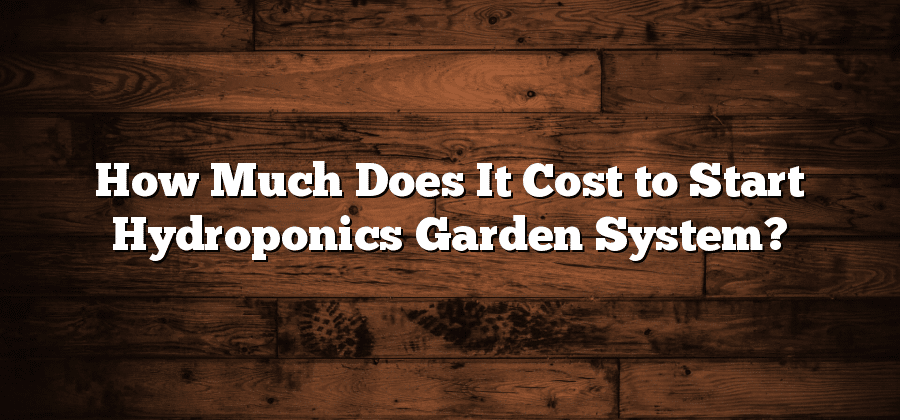Essential Components of a Hydroponics Garden System
A hydroponics garden system is an innovative and efficient way of growing plants without soil. When setting up a hydroponics garden, there are several essential components that are required for a successful and thriving system. One of the key components is a nutrient solution, which provides the necessary elements and minerals needed for plant growth. This solution is typically made by mixing specific ratios of water and nutrient concentrates, ensuring that plants receive the optimal nutrition they need.
Another crucial component is a suitable growing medium, which replaces traditional soil in a hydroponics garden. The growing medium acts as a support system for the plants’ roots and allows for the proper distribution of water, nutrients, and oxygen. Some commonly used growing mediums include perlite, coco coir, rockwool, and clay pebbles. The choice of growing medium depends on factors such as the type of plants being grown, availability, and personal preference. Additionally, a robust and well-designed irrigation system is vital in a hydroponics garden. This system ensures that plants receive a continuous and regulated supply of water and nutrients, promoting healthy growth and minimizing water waste. Overall, the essential components of a hydroponics garden system work together to create an environment where plants can thrive and flourish, resulting in higher yields and healthier produce.
Evaluating the Initial Investment of Hydroponics Gardening
Hydroponics gardening has gained popularity in recent years due to its numerous advantages over traditional soil-based gardening. However, before diving into this innovative method, it is essential to evaluate the initial investment of setting up a hydroponics garden. While the initial costs may seem daunting, they can be justified by the long-term benefits.
The main components of a hydroponics garden system include grow lights, nutrient solutions, growing media, and a suitable structure or container for the plants. Each of these components comes with varying costs depending on their quality and size. Additionally, the size of the hydroponics system will also affect the overall investment. Smaller systems may require less initial capital, while larger systems may require more funds upfront.
Furthermore, it is crucial to consider the cost of additional equipment and infrastructure. This may include items such as water pumps, air circulation systems, and monitoring devices. These components are necessary to maintain optimal conditions for plant growth in a hydroponics system. Evaluating the initial investment of hydroponics gardening requires a careful assessment of these factors to determine the feasibility and cost-effectiveness of starting a hydroponics garden system.
Factors Affecting the Cost of Starting a Hydroponics Garden
When considering starting a hydroponics garden, it is essential to understand the factors that can affect the overall cost. One of the primary factors that impacts expenses is the size of the garden. The larger the garden, the more equipment and infrastructure will be required, leading to higher costs. Additionally, the type of plants you wish to grow will also influence the expenses. Some plants require more specialized equipment and nutrients, which can increase the initial investment.
Another factor to consider is the complexity of the hydroponics system. There are different types of systems available, ranging from simple to more advanced setups. While basic systems may be more affordable, they may also have limitations in terms of plant variety and growth potential. On the other hand, advanced systems provide more control and flexibility but tend to be pricier. It is crucial to assess your budget and prioritize your needs and goals when selecting the right hydroponics system for your garden.
Selecting the Right Hydroponics System for Your Budget
When it comes to selecting the right hydroponics system for your budget, there are a few key factors to consider. First and foremost, you need to determine how much you are willing to invest in setting up your hydroponics garden. Keep in mind that while hydroponics can be a cost-effective and efficient way to grow plants, it does require an initial investment in equipment and infrastructure.
Once you have a clear budget in mind, the next step is to research different types of hydroponics systems available in the market. There are various options to choose from, including nutrient film technique (NFT), deep water culture (DWC), and drip systems, just to name a few. Each system has its own advantages and disadvantages, so it’s important to weigh these factors against your budget. Additionally, consider the specific needs of the plants you intend to grow, as certain systems may be better suited for different types of crops. By carefully evaluating your budget and the available options, you can choose a hydroponics system that not only meets your financial constraints but also provides optimal conditions for your plants to thrive.
Calculating Costs: Equipment and Infrastructure
Hydroponics gardening offers a viable alternative to traditional soil-based cultivation, allowing individuals to grow plants using nutrient-rich water solutions. However, before embarking on this method, it is essential to evaluate the costs associated with the necessary equipment and infrastructure. Calculating these costs upfront can help prospective gardeners make informed decisions regarding their budget and investment.
When considering the equipment required for a hydroponics garden, the choice of system plays a significant role in determining costs. There are various hydroponics systems available, ranging from simple and cost-effective setups to more complex and sophisticated ones. Factors such as plant type, space availability, and desired level of automation should be considered when selecting a system. Additionally, calculating costs should also include essential components like grow lights, pumps, timers, pH meters, and monitoring devices. Evaluating the quality and durability of these pieces of equipment is crucial to ensure long-term success and minimize the risk of costly replacements or repairs.






